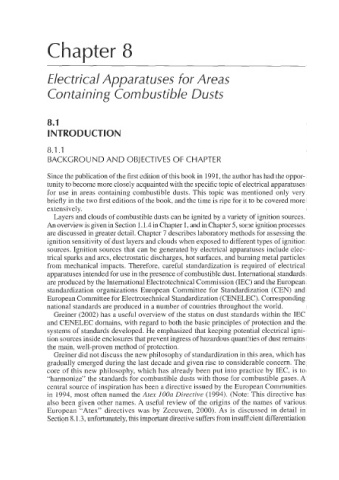Page 582 - Dust Explosions in the Process Industries
P. 582
Chapter 8
ctrical Apparatuses for Areas
Containing Cornbustible Dusts
.I
I NTRODUCTlON
8.1 .I
ACKGROUND AND OBJECTIVESOF CHAPTER
Sincethe publication of the first edition of this book in 1991, the author has had the oppor-
tunity to become more closely acquainted with the specifictopic of electricalapparatuses
for use in areas containing combustible dusts. This topic was mentioned only very
briefly in the two first editions of the book, and the time is ripe for it to be covered more
extensively.
Layers and clouds of combustible dusts can be ignited by a variety of ignition sources.
An overviewis given in Section 1.1.4in Chapter 1,and in Chapter5, someignitionprocesses
are discussed in greater detail. Chapter 7 describes laboratory methods for assessing the
ignition sensitivity of dust layers and clouds when exposed to differenttypes of ignition
sources. Ignition sources that can be generated by electrical apparatuses include elec-
trical sparks and arcs, electrostatic discharges,hot surfaces, and burning metal particles
from mechanical impacts. Therefore, careful standardization is required of electrical
apparatusesintended for use in the presence of combustible dust. Internationalstandards
are produced by the InternationalElectrotechnicalCommission (IEC) and the European
standardization organizations European Committee for Standardization (CEN) and
European Committeefor ElectrotechnicalStandardization(CENELEC). Corresponding
national standards are produced in a number of countries throughout the world.
Greiner (2002) has a useful overview of the status on dust standards within the IEC
and CENELEC domains, with regard to both the basic principles of protection and the
systems of standards developed. He emphasized that keeping potential electrical igni-
tion sources inside enclosures that prevent ingress of hazardous quantities of dust remains
the main, well-proven method of protection.
Greiner did not discuss the new philosophy of standardizationin this area, which has
gradually emerged during the last decade and given rise to considerable concern. The
core of this new philosophy, which has already been put into practice by IEC, is to
“harmonize” the standards for combustible dusts with those for combustible gases. A
central source of inspiration has been a directive issued by the European Communities
in 1994, most often named the Atex lOOa Directive (1994). (Note: This directive has
also been given other names. A useful review of the origins of the names of various
European “Atex” directives was by Zeeuwen, 2000). As is discussed in detail in
Section8.1.3,unfortunately,this important directivesuffersfrom insufficientdifferentiation

